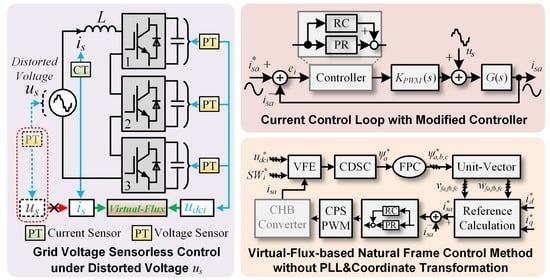Voltage-Sensorless Natural Frame Control for Single-Phase CHB Converter under Distorted Grid Conditions
Abstract
:1. Introduction
2. Theoretical Analysis under Distorted Grid Voltage
2.1. Mathematical Model of Single-Phase 3-Cell CHB Converter
2.2. Extraction of Fundamental Sinusoidal Signal under Distorted Grid Conditions
3. Grid Voltages Sensorless Method Based on Virtual Flux Estimation
3.1. Principles of VF Estimation
3.2. VFE Based on Three Cascaded First-Order Low-Pass Filters
4. Natural Frame Control Based on Virtual Flux
4.1. Principles of VF-Based NFC
4.2. Analysis and Design of Current Controller under Distorted Grid Conditions
5. Experiment Research
6. Conclusions
Author Contributions
Funding
Institutional Review Board Statement
Informed Consent Statement
Data Availability Statement
Acknowledgments
Conflicts of Interest
References
- Kroposki, B.; Lasseter, R.; Ise, T.; Morozumi, S.; Papathanassiou, S.; Hatziargyriou, N. Making microgrids work. IEEE Power Energy Mag. 2008, 6, 40–53. [Google Scholar] [CrossRef]
- Kumar, D.; Zare, F. Harmonic Analysis of Grid Connected Power Systems in Low Voltage Distribution Networks. IEEE J. Emerg. Sel. Top. Power Electron. 2016, 4, 70–79. [Google Scholar] [CrossRef]
- Han, Y.; Luo, M.; Zhao, X.; Guerrero, J.M.; Xu, L. Comparative Performance Evaluation of Orthogonal-Signal-Generators-Based Single-Phase PLL Algorithms—A Survey. IEEE Trans. Power Electron. 2016, 31, 3932–3944. [Google Scholar] [CrossRef] [Green Version]
- Golestan, S.; Guerrero, J.M.; Vasquez, J.C. Single-Phase PLLs: A Review of Recent Advances. IEEE Trans. Power Electron. 2017, 32, 9013–9030. [Google Scholar] [CrossRef]
- Rodriguez, P.; Luna, A.; Ciobotaru, M.; Teodorescu, R.; Blaabjerg, F. Advanced Grid Synchronization System for Power Converters under Unbalanced and Distorted Operating Conditions. In Proceedings of the IECON 2006-32nd Annual Conference on IEEE Industrial Electronics, Paris, France, 6–10 November 2006; pp. 5173–5178. [Google Scholar] [CrossRef]
- Yang, D.; Chen, S.; Zhang, X.; Yang, L.; Liu, J.; Shao, D. Modified natural frame control of single-phase cascaded H-bridge multilevel converter under distorted grid voltage. IET Power Electron. 2021, 14, 1008–1017. [Google Scholar] [CrossRef]
- Li, T.; Li, Y.; Yang, J.; Ge, W.; Hu, B. A Modified DSC-Based Grid Synchronization Method for a High Renewable Penetrated Power System Under Distorted Voltage Conditions. Energies 2019, 12, 4040. [Google Scholar] [CrossRef] [Green Version]
- Golestan, S.; Guerrero, J.M.; Vasquez, J.C.; Abusorrah, A.M.; Al-Turki, Y. Advanced Single-Phase DSC-Based PLLs. IEEE Trans. Power Electron. 2019, 34, 3226–3238. [Google Scholar] [CrossRef]
- Wang, X.; Ruan, X.; Liu, S.; Tse, C.K. Full Feedforward of Grid Voltage for Grid-Connected Inverter with LCL Filter to Suppress Current Distortion due to Grid Voltage Harmonics. IEEE Trans. Power Electron. 2010, 25, 3119–3127. [Google Scholar] [CrossRef]
- Zhou, L.; Shuai, Z.; Chen, Y.; Wu, W.; Zhou, X. Impedance-Based Harmonic Current Suppression Method for VSG Connected to Distorted Grid. IEEE Trans. Ind. Electron. 2020, 67, 5490–5502. [Google Scholar] [CrossRef]
- Holmes, D.G.; Lipo, T.A.; McGrath, B.P.; Kong, W.Y. Optimized Design of Stationary Frame Three Phase AC Current Regulators. IEEE Trans. Power Electron. 2009, 24, 2417–2426. [Google Scholar] [CrossRef]
- Yuan, X.; Merk, W.; Stemmler, H.; Allmeling, J. Stationary-frame generalized integrators for current control of active power filters with zero steady-state error for current harmonics of concern under unbalanced and distorted operating conditions. IEEE Trans. Ind. Appl. 2002, 38, 523–532. [Google Scholar] [CrossRef]
- Jia, Y.; Zhao, J.; Fu, X. Direct Grid Current Control of LCL-Filtered Grid-Connected Inverter Mitigating Grid Voltage Disturbance. IEEE Trans. Power Electron. 2014, 29, 1532–1541. [Google Scholar] [CrossRef]
- Castilla, M.; Miret, J.; Camacho, A.; Matas, J.; de Vicuna, L.G. Reduction of Current Harmonic Distortion in Three-Phase Grid-Connected Photovoltaic Inverters via Resonant Current Control. IEEE Trans. Ind. Electron. 2013, 60, 1464–1472. [Google Scholar] [CrossRef]
- Zhong, Q.; Hornik, T. Cascaded Current–Voltage Control to Improve the Power Quality for a Grid-Connected Inverter with a Local Load. IEEE Trans. Ind. Electron. 2013, 60, 1344–1355. [Google Scholar] [CrossRef]
- Hornik, T.; Zhong, Q. A Current-Control Strategy for Voltage-Source Inverters in Microgrids Based on H∞ and Repetitive Control. IEEE Trans. Power Electron. 2011, 26, 943–952. [Google Scholar] [CrossRef]
- Yang, Y.; Zhou, K.; Blaabjerg, F. Current Harmonics from Single-Phase Grid-Connected Inverters—Examination and Suppression. IEEE J. Emerg. Sel. Top. Power Electron. 2016, 4, 221–233. [Google Scholar] [CrossRef] [Green Version]
- Trinh, Q.N.; Wang, P.; Tang, Y.; Choo, F.H. Mitigation of DC and Harmonic Currents Generated by Voltage Measurement Errors and Grid Voltage Distortions in Transformerless Grid-Connected Inverters. IEEE Trans. Energy Convers. 2018, 33, 801–813. [Google Scholar] [CrossRef]
- Blaabjerg, F.; Teodorescu, R.; Liserre, M.; Timbus, A.V. Overview of Control and Grid Synchronization for Distributed Power Generation Systems. IEEE Trans. Ind. Electron. 2006, 53, 1398–1409. [Google Scholar] [CrossRef] [Green Version]
- Yang, D.; Wu, N.; Yin, L.; Lu, Z. Natural Frame Control of Single-Phase Cascaded H-Bridge Multilevel Converter Based on Fictive-Phases Construction. IEEE Trans. Ind. Electron. 2018, 65, 3848–3857. [Google Scholar] [CrossRef]
- Zhang, C.; Wang, X.; Blaabjerg, F. Analysis of phase-locked loop influence on the stability of single-phase grid-connected inverter. In Proceedings of the 2015 IEEE 6th International Symposium on Power Electronics for Distributed Generation Systems (PEDG), Aachen, Germany, 22–25 June 2015; pp. 1–8. [Google Scholar] [CrossRef] [Green Version]
- Xu, J.; Qian, Q.; Zhang, B.; Xie, S. Harmonics and Stability Analysis of Single-Phase Grid-Connected Inverters in Distributed Power Generation Systems Considering Phase-Locked Loop Impact. IEEE Trans. Sustain. Energy 2019, 10, 1470–1480. [Google Scholar] [CrossRef]
- Ketzer, M.B.; Jacobina, C.B. Virtual Flux Sensorless Control for Shunt Active Power Filters with Quasi-Resonant Compensators. IEEE Trans. Power Electron. 2016, 31, 4818–4830. [Google Scholar] [CrossRef]
- Rahoui, A.; Bechouche, A.; Seddiki, H.; Abdeslam, D.O. Grid voltages estimation for three-phase PWM rectifiers control without AC voltage sensors. IEEE Trans. Power Electron. 2018, 33, 859–875. [Google Scholar] [CrossRef]
- Liang, J.; Wang, H.; Yan, Z. Grid Voltage Sensorless Model-Based Predictive Power Control of PWM Rectifiers Based on Sliding Mode Virtual Flux Observer. IEEE Access 2019, 7, 24007–24016. [Google Scholar] [CrossRef]
- Rahoui, A.; Bechouche, A.; Seddiki, H.; Abdeslam, D.O. Virtual Flux Estimation for Sensorless Predictive Control of PWM Rectifiers Under Unbalanced and Distorted Grid Conditions. IEEE J. Emerg. Sel. Top. Power Electron. 2021, 9, 1923–1937. [Google Scholar] [CrossRef]
- Suul, J.A.; Luna, A.; Rodriguez, P.; Undeland, T. Voltage-Sensor-Less Synchronization to Unbalanced Grids by Frequency-Adaptive Virtual Flux Estimation. IEEE Trans. Ind. Electron. 2012, 59, 2910–2923. [Google Scholar] [CrossRef]
- Zhang, H.; Zhu, X.; Shi, J.; Tan, L.; Zhang, C.; Hu, K. Study on PWM Rectifier Without Grid Voltage Sensor Based on Virtual Flux Delay Compensation Algorithm. IEEE Trans. Power Electron. 2019, 34, 849–862. [Google Scholar] [CrossRef]
- Yang, D.; Chen, S.; Chen, S.; Liu, J. AC Voltage Sensorless-Based Natural Frame Control of Cascaded H-Bridge Converter Based on Virtual Flux Observer. IEEE Access 2020, 8, 191930–191941. [Google Scholar] [CrossRef]
- Wang, T.; Nian, H.; Zhu, Z.Q.; Ding, L.; Zhou, B. Flexible Compensation Strategy for Voltage Source Converter under Unbalanced and Harmonic Condition Based on a Hybrid Virtual Impedance Method. IEEE Trans. Power Electron. 2018, 33, 7656–7673. [Google Scholar] [CrossRef]
- Zhong, M.; Tong, X.; Huang, J. The strategy of second harmonic voltage match suppression for the DC-link in inverter. Energy Rep. 2022, 8, 188–195. [Google Scholar] [CrossRef]
- Bu, W.S.; Xu, L.L. Improved Virtual-Flux-Linkage Observation Method of PWM Rectifier. Appl. Mech. Mater. 2014, 678, 528–532. [Google Scholar] [CrossRef]
- Zhang, Y.; Wang, Z.; Jiao, J.; Liu, J. Grid-voltage sensorless model predictive control of three-phase PWM rectifier under unbalanced and distorted grid voltages. IEEE Trans. Power Electron. 2019, 35, 8663–8672. [Google Scholar] [CrossRef]
- Guo, L.; Jin, N.; Li, Y.; Luo, K. A Model Predictive Control Method for Grid-Connected Power Converters without AC Voltage Sensors. IEEE Trans. Ind. Electron. 2021, 68, 1299–1310. [Google Scholar] [CrossRef]
- Tao, Y.K.; Wu, Q.; Tang, L.; Wang, L. Voltage sensorless predictive direct power control of three-phase PWM converters. IET Power Electron. 2016, 9, 1009–1018. [Google Scholar] [CrossRef]




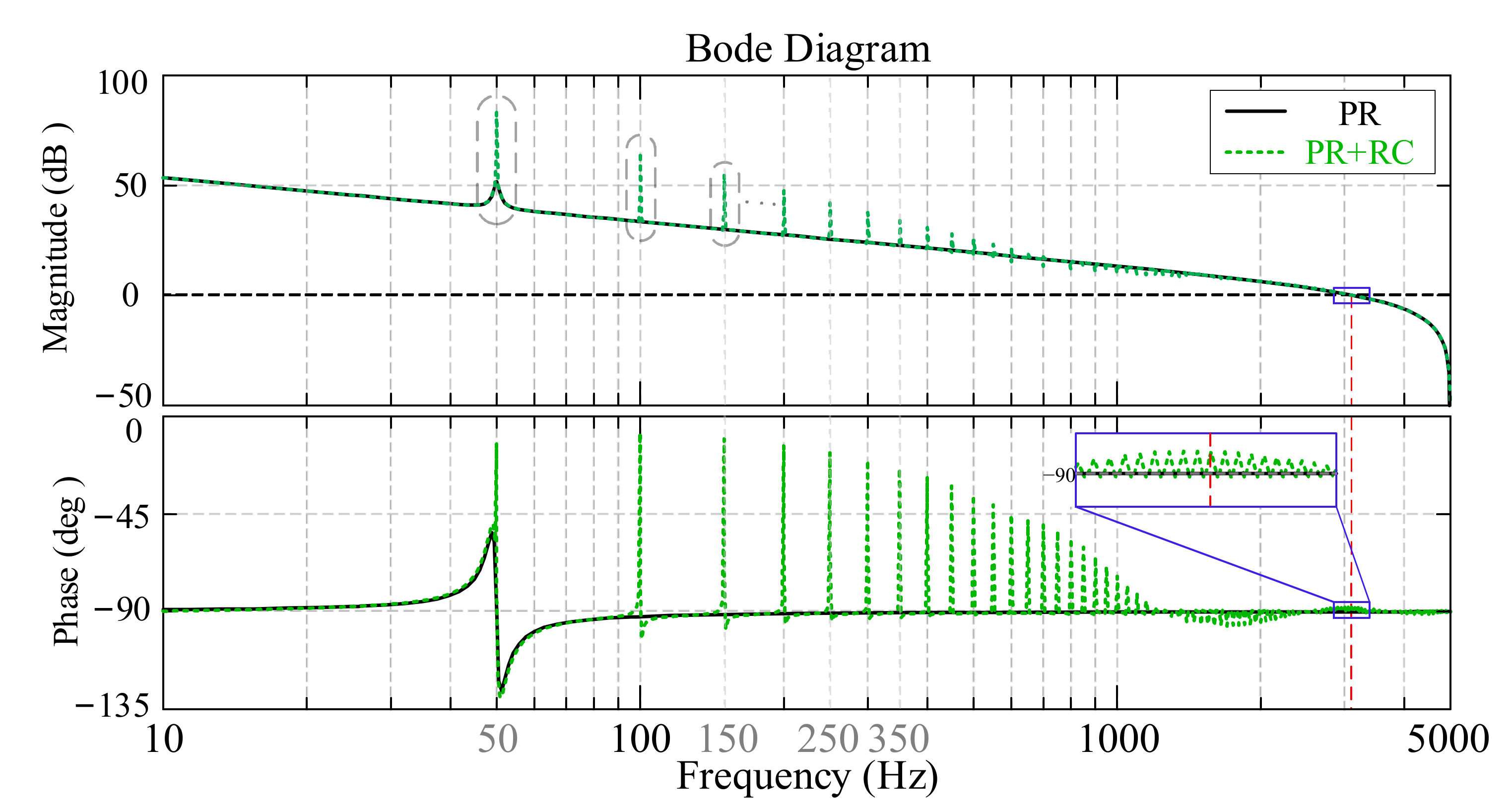

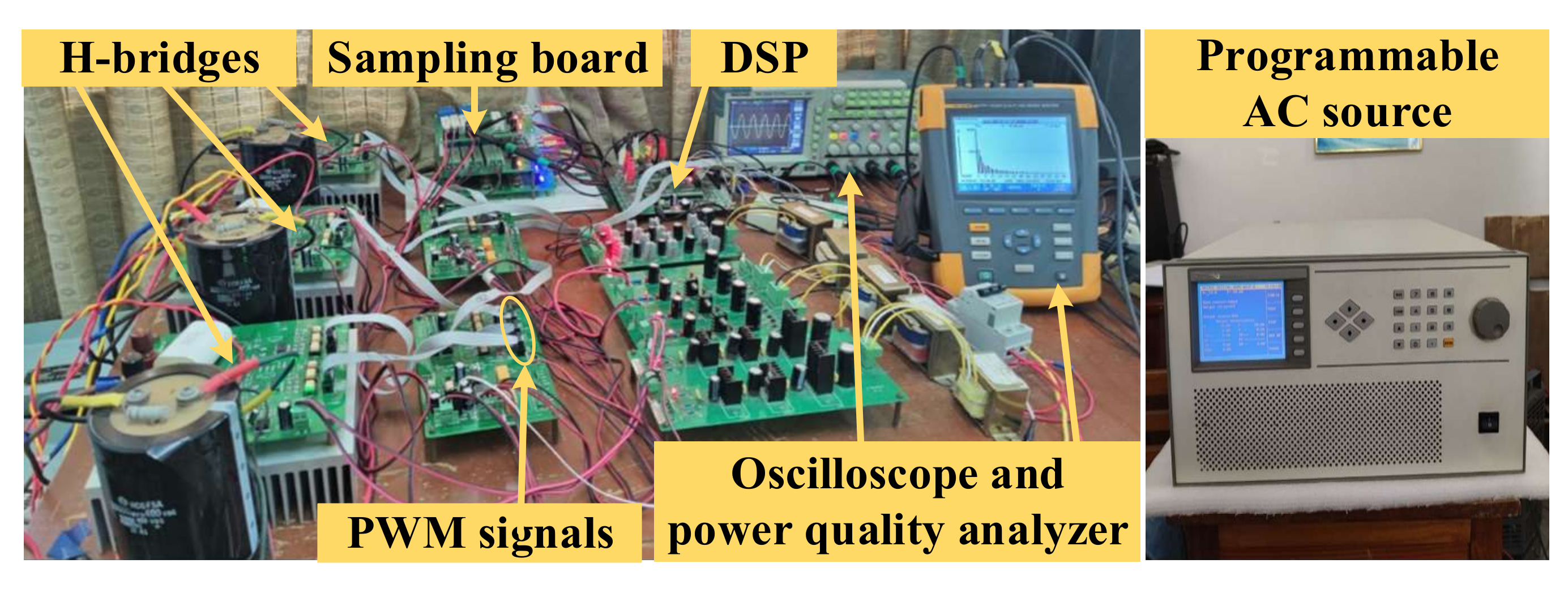

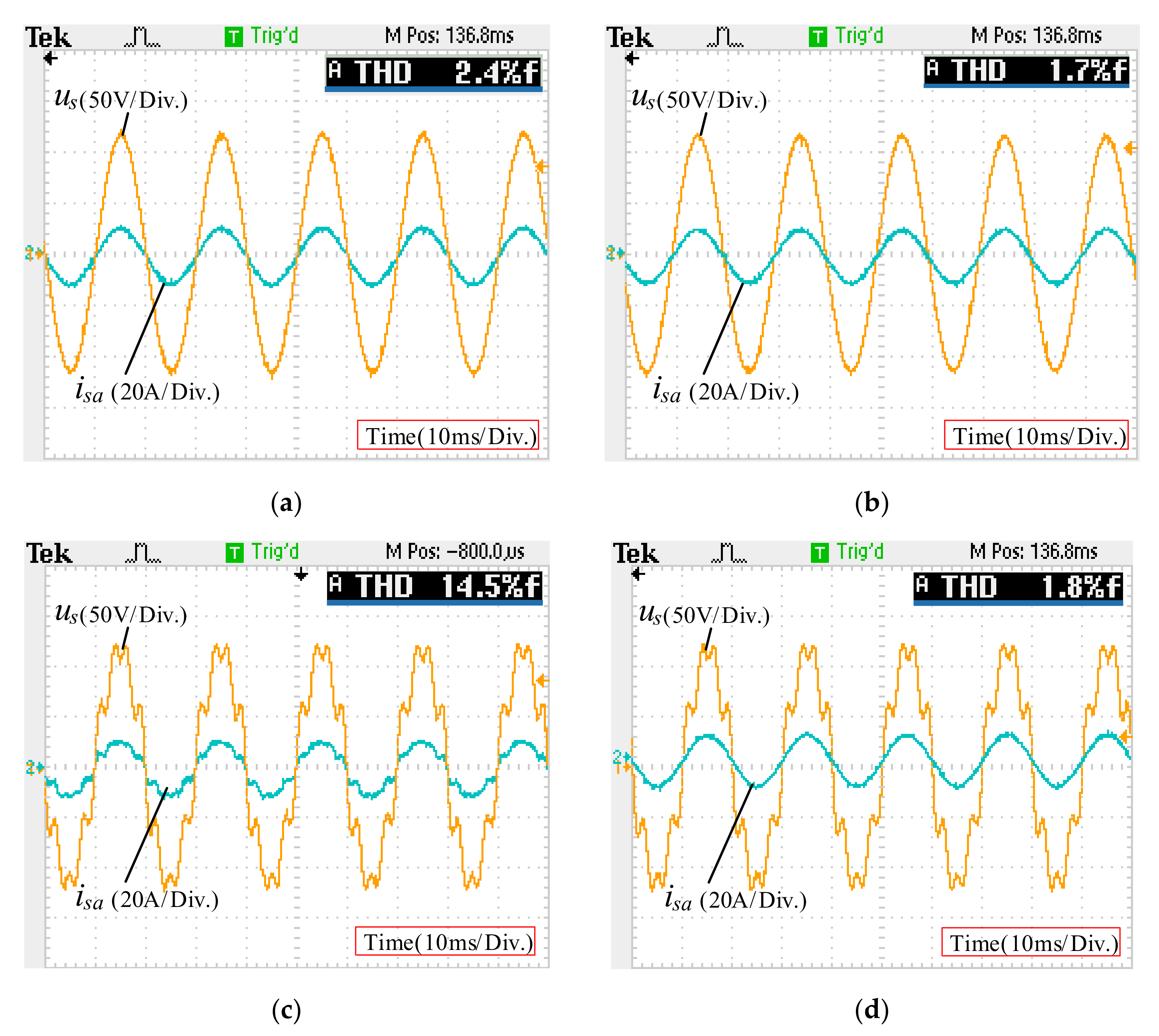
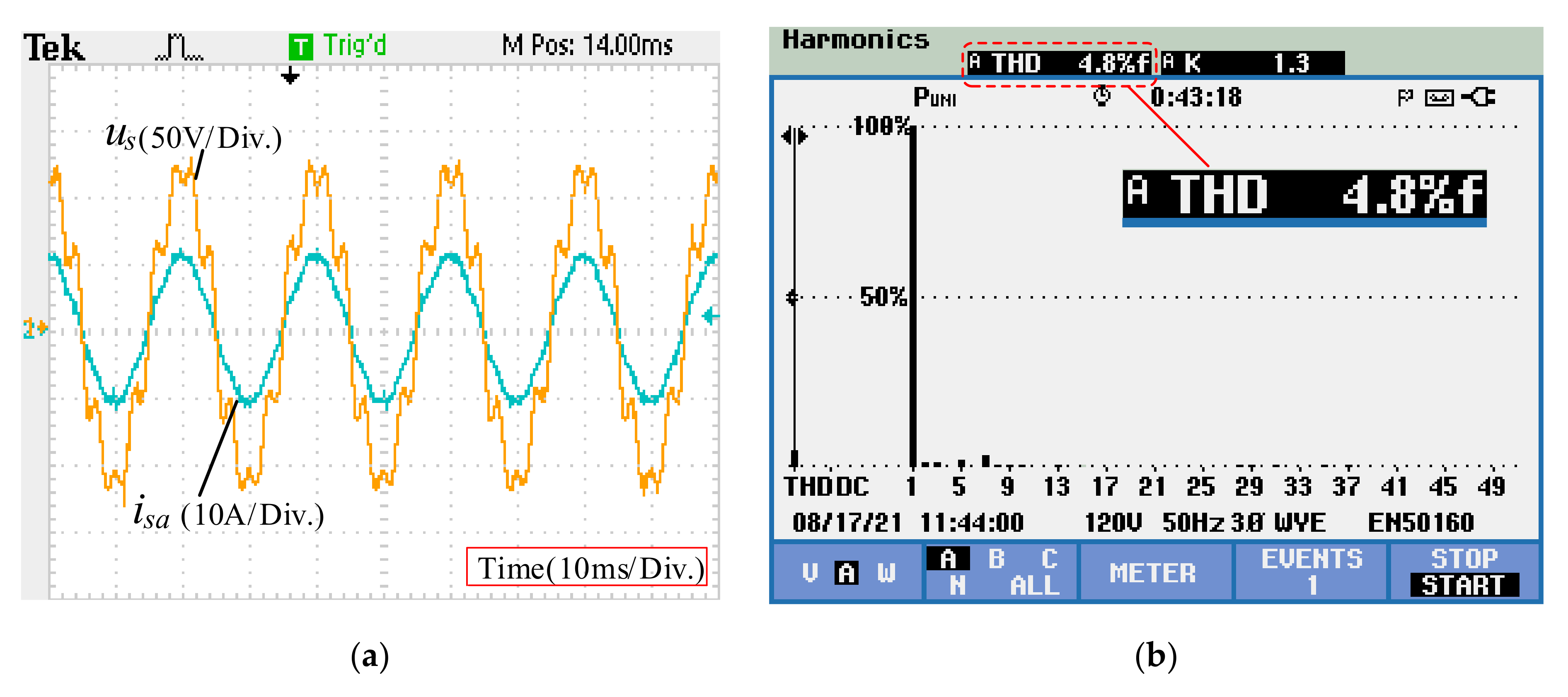
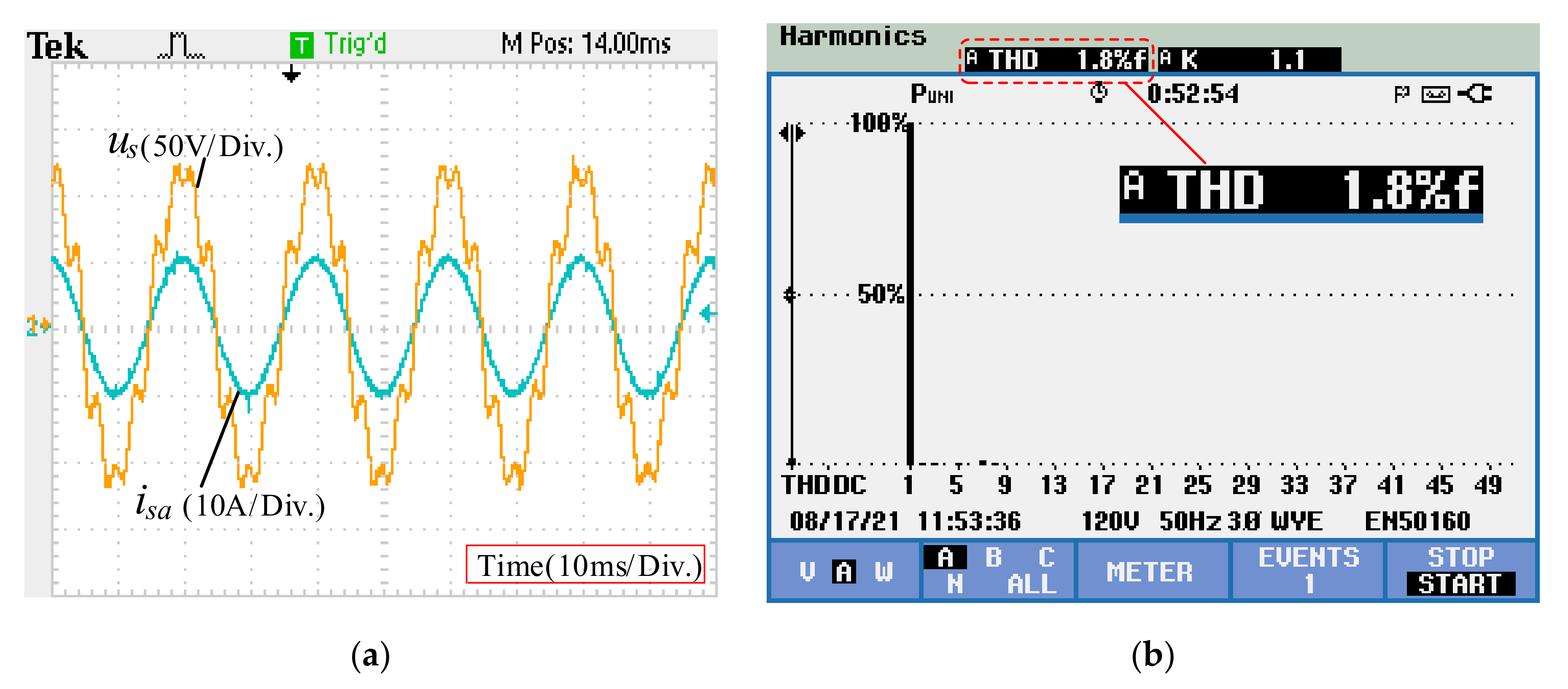

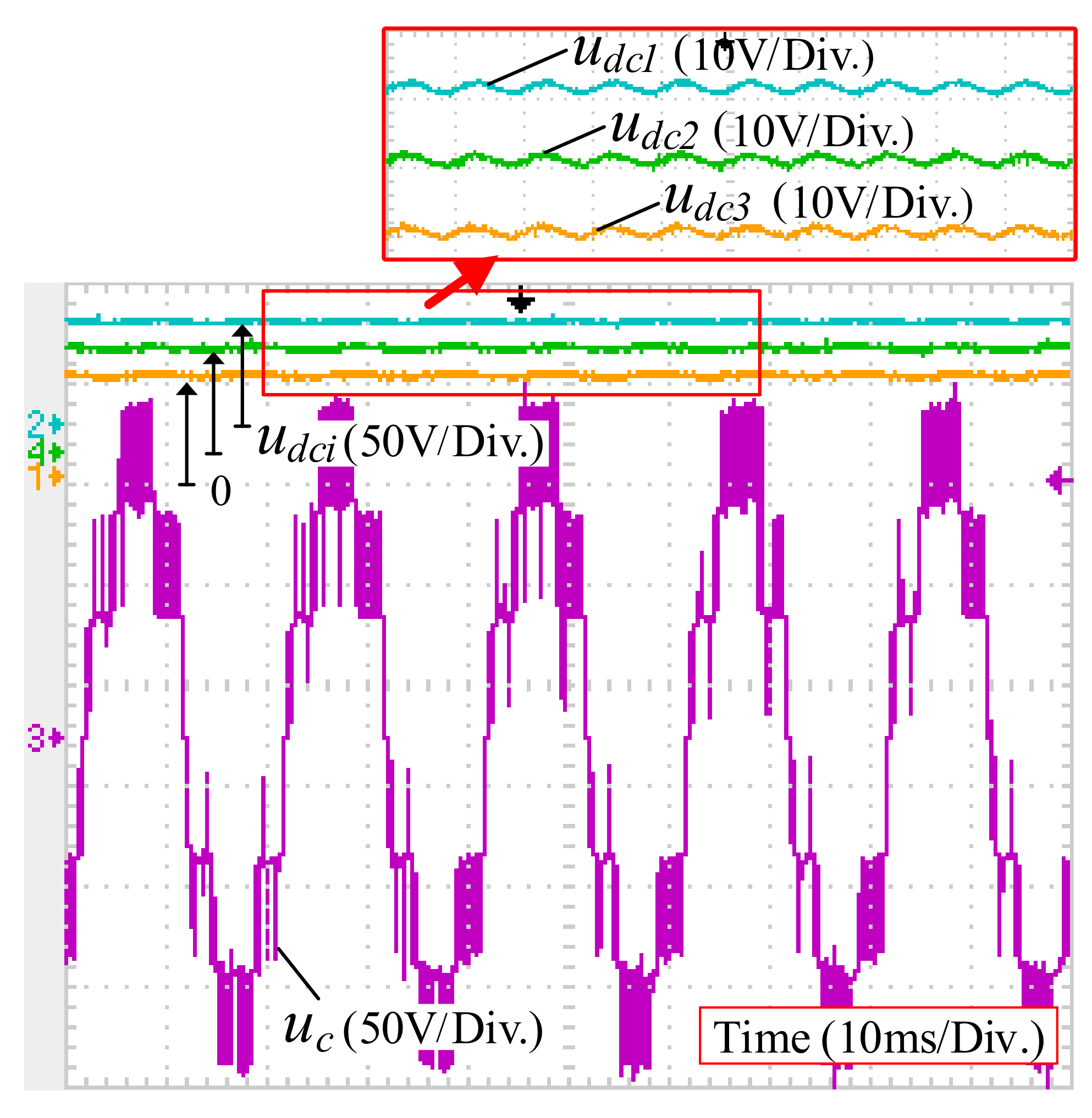
| Parameters | Symbol | Value |
|---|---|---|
| Grid voltage (RMS) | us | 80 V |
| DC-side reference voltage | u*ref | 150 V |
| AC-side filter’s inductor | L | 3.34 mH |
| DC-side capacitor | C | 1000 μF |
| DC-side load resistance | RLi | 15 Ω |
| Frequency of fundamental voltage | f | 50 Hz |
| Sampling frequency | fs | 12.8 kHz |
| RC | Krc, α, β, m | 1.8, 0.125, 0.75, 4 |
| PR controller | Kp, Kr, ωc | 100, 1200, 3.14 |
| DC cluster voltage controller | Kcp, Kci | 0.8, 12 |
| DC voltage balancing controller | Kvp | 10 |
| Sensorless Method | Inner Loop Controller | Topology of Main Circuit | Power Rate (per Phase) | Harmonics Content of Grid Voltage | THD of Output Current | Harmonics Rejection Ability |
|---|---|---|---|---|---|---|
| SMVO [34] | MPC | Three-phase full-wave rectifier | 610 W | 10% 7th | 6.27% | Poor |
| LPF-VFE [35] | PDPC | Three-phase full-wave rectifier | 480 W | 5% 5th | 3.93% | Good |
| The proposed method | PR+RC | Single-phase CHB converter | 800 W | 2.3% 2nd, 9.8% 5th, 15.8% 7th, 2.5% 8th | 1.8% | better |
Publisher’s Note: MDPI stays neutral with regard to jurisdictional claims in published maps and institutional affiliations. |
© 2022 by the authors. Licensee MDPI, Basel, Switzerland. This article is an open access article distributed under the terms and conditions of the Creative Commons Attribution (CC BY) license (https://creativecommons.org/licenses/by/4.0/).
Share and Cite
Shao, D.; Liu, J.; Yang, D.; Peng, Z.; Li, Z. Voltage-Sensorless Natural Frame Control for Single-Phase CHB Converter under Distorted Grid Conditions. Energies 2022, 15, 769. https://doi.org/10.3390/en15030769
Shao D, Liu J, Yang D, Peng Z, Li Z. Voltage-Sensorless Natural Frame Control for Single-Phase CHB Converter under Distorted Grid Conditions. Energies. 2022; 15(3):769. https://doi.org/10.3390/en15030769
Chicago/Turabian StyleShao, Dashuai, Jinbao Liu, Daliang Yang, Zuwen Peng, and Zheng Li. 2022. "Voltage-Sensorless Natural Frame Control for Single-Phase CHB Converter under Distorted Grid Conditions" Energies 15, no. 3: 769. https://doi.org/10.3390/en15030769
APA StyleShao, D., Liu, J., Yang, D., Peng, Z., & Li, Z. (2022). Voltage-Sensorless Natural Frame Control for Single-Phase CHB Converter under Distorted Grid Conditions. Energies, 15(3), 769. https://doi.org/10.3390/en15030769





